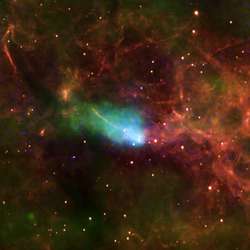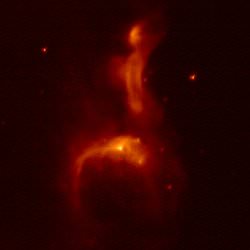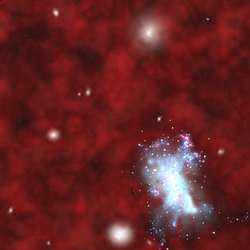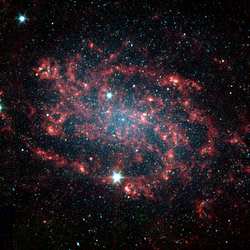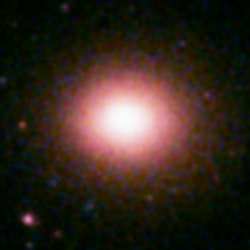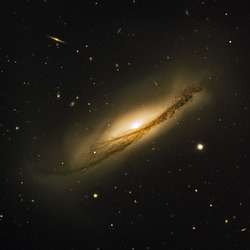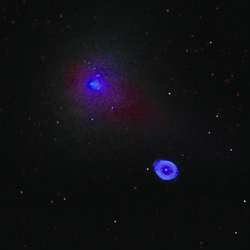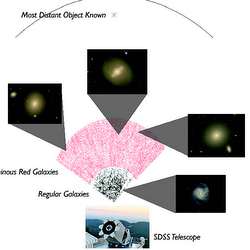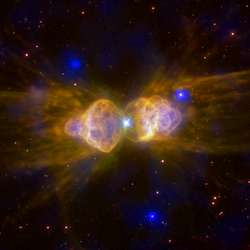New images from the Gemini telescope show two paths stars can take as they near the end of their lives. One is NGC 6164-5, an emission nebula with an inverted S-shaped appearance. It’s 4,200 light-years away and contains a very massive star ejecting material – it should explode as a supernova in a few million years. The other, NGC 5189, contains a star much more similar to our own Sun. As it nears the end of the its life, the star blowing off its thin atmosphere into space, which collides with previously ejected clouds of gas.
Two new images from Gemini Observatory released today at the American Astronomical Society meeting in Calgary, Canada, show a pair of beautiful nebulae that were created by two very different types of stars at what may be similar points in their evolutionary timelines. One is a rare type of very massive spectral-type “O” star surrounded by material it ejected in an explosive event earlier in its life. It continues to lose mass in a steady “stellar wind.” The other is a star originally more similar to our Sun that has lost its outer envelope following a “red giant” phase. It continues to lose mass via a stellar wind as it dies, forming a planetary nebula. The images were made using the Gemini Multi-Object Spectrograph (GMOS) on Gemini
The first image shows the emission nebula NGC 6164-5, a rectangular, bipolar cloud with rounded corners and a diagonal bar producing an inverted S-shaped appearance. It lies about 1,300 parsecs (4,200 light-years) away in the constellation Norma. The nebula measures about 1.3 parsecs (4.2 light-years) across, and contains gases ejected by the star HD 148937 at its heart. This star is 40 times more massive than the Sun, and at about three to four million years of age, is past the middle of its life span. Stars this massive usually live to be only about six million years old, so HD 148397 is aging fast. It will likely end its life in a violent supernova explosion.
Like other O-type stars, HD148937 is heating up its surrounding clouds of gas with ultraviolet radiation. This causes them to glow in visible light, illuminating swirls and caverns in the cloud that have been sculpted by winds from the star. Some astronomers suggest that the cloud of material has been ejected from the star as it spins on its axis, in much the same way a rotating lawn sprinkler shoots out water as it spins. It’s also possible that magnetic fields surrounding the star may play a role in creating the complex shapes clearly seen in the new Gemini image.
Astronomers are also studying several “cometary knots” out on the boundaries of the cloud that are similar to those seen in planetary nebulae such as the Eskimo Nebula (NGC 2392) and the Helix Nebula (NGC 7293). These cometary knots (so called because they seem to resemble comets with their tails pointing away from the star) are inside what appears to be a low-density cavity in the cloud. The knots may be a result of the denser, slower shells being impacted by the faster stellar wind, as observed in planetary nebulae (formed during the deaths of much less massive stars like the Sun).
Massive stars like HD 148937 burn hydrogen to helium in a process called the CNO cycle. As a byproduct, carbon and oxygen are converted into nitrogen, so the appearance of enhanced nitrogen at the surface of the star or in the material it also blows off indicates an evolved star. According to astronomer Nolan Walborn of the Space Telescope Science Institute, who has been studying this star from the ground for several years now, it is a member of a very small class of O stars with certain peculiar spectral characteristics. “The ejected, nitrogen-rich nebulosities of HD 148937 suggest an evolved star, and a possible relationship to a class of star known as luminous blue variables,” he said.
Luminous blue variables are very massive, unstable stars advanced in their evolution. Many have nitrogen-rich nebulae that are arrayed symmetrically around the stars, similar to what we see in NGC 6164-5. One of the best-known examples is the star Eta Carinae, which ejected a nebula during an outburst in the 1840s.
Just as astronomers are still seeking to understand the process of mass loss from a star like HD 158937, they are also searching out the exact mechanisms at play when a star like the Sun begins to age and die. NGC 5189, a chaotic-looking planetary nebula that lies about 550 parsecs (1,800 light-years) away in the southern hemisphere constellation Musca, is a parallelogram-shaped cloud of glowing gas. The GMOS image of this nebula shows long streamers of gas, glowing dust clouds, and cometary knots pointing away from the central star. Its unruly appearance suggests some extraordinary action at the heart of this planetary nebula.
***image4:left***At the core of NGC 5189 is the hot, hydrogen-deficient star HD 117622. It appears to be blowing off its thin remnant atmosphere into interstellar space at a speed of about 2,700 kilometers (about 1,700 miles) per second. As the material leaves the star, it immediately begins to collide with previously ejected clouds of gas and dust surrounding the star. This collision of the fast-moving material with slower motion gas shapes the clouds, which are illuminated by the star. These so-called “low ionization structures” (or LIS) show up as the knots, tails, streamers, and jet-like structures we see in the Gemini image. The structures are small and not terribly bright, lending planetary nebulae their often-ghostly appearance.
“The likely mechanism for the formation of this planetary nebula is the existence of a binary companion to the dying star,” said Gemini scientist Kevin Volk. “Over time the orbits drift due to precession and this could result in the complex curves on the opposite sides of the star visible in this image.”
NGC 5189 was discovered by Scottish observer James Dunlop in 1826. when Sir John Herschel observed it in 1835 he described it as a “strange” object. It was not immediately identified as a planetary nebula, but its peculiar spectra, shows emission lines of ionized helium, hydrogen, sulfur and oxygen. These all indicate elements being burned inside the star as it ages and dies.As the material is blown out to space, it forms concentric shells of various gases from elements that were created in the star’s nuclear furnace.
The Gemini data used to produce these images is being released to the astronomical community for further research and follow-up analysis. Note to astronomers: Data can be found at the Gemini Science Archive by querying “NGC 6164” and “NGC 5189.”
Original Source: Gemini Observatory

